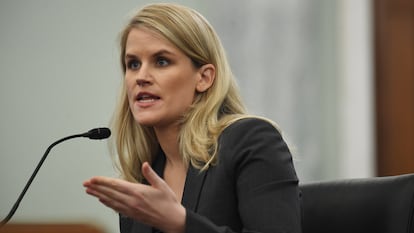The New Tobacco Companies: The Wave of Lawsuits That Could End Social Networking | technology

Social networks are facing a massive collapse in the United States, and their business model has been marked by a tsunami of lawsuits from individuals, educational institutions, and state attorneys general. They accuse the platforms of intentionally harming the mental health of young people. And not just because of the content they help disseminate: The very design of the product, used by litigants, is addictively seeking to trap the user. The more time people spend hanging on the screen, the greater the economic benefits of advertising. This vicious cycle, the lawsuits say, has horrific effects among children and teens who struggle with depression, eating disorders or even suicidal tendencies.
A 16-year-old girl from Utah becomes so obsessed with her body image after becoming so hooked on Instagram that she develops anorexia and bulimia. A nine-year-old boy from Michigan spends so many nights watching videos on YouTube, TikTok and Snapchat that he ended up posting a nude photo of himself that went viral. An 11-year-old Connecticut girl struggled with severe addiction to Instagram and Snapchat for two years before developing insomnia and depression which led to her suicide. These horrific cases, aired last year by bloombergare some of those involved in hundreds of private lawsuits filed against social networks in recent months.
Two hundred of them met in class action, a number in the US legal system similar to class action lawsuits. The brief charges filed in the Northern California area in March are Meta (for Facebook and Instagram), Snap (for Snapchat), ByteDance (the company that owns TikTok) and Google (for YouTube), which it accuses of seriously harming mental health. Health of Young Americans. The process is currently in the arguments stage. The US Supreme Court has to decide in June whether the lawsuit will move forward or be dismissed.
This newspaper contacted the four technology companies to find out their position regarding the operation. They all declined to comment specifically on the lawsuit, other than to confirm that they are taking steps to strengthen content control. “We’ve developed more than 30 tools to support teens and their families, including features that allow parents to decide when and for how long their children can use Instagram,” says Antigone Davis, Global Director of Safety at Meta. The company run by Mark Zuckerberg has just reached an out-of-court agreement to compensate the Facebook users whose data was leaked to Cambridge Analytica $725 million (about €653 million).
“Our case is not just focused on the content of the platforms, it goes deeper than that. We allude to the very design of social networks: from systems of age verification, or lack thereof, to various characteristics of the platform itself which, depending on what we maintain, are specifically designed to be addictive Joseph explained to EL PAÍS by video. VanZandt from the Beasley Allen Company. This attorney heads the board of jurists that coordinates the class action, where two other law firms and several private attorneys operate.

Everything from the way videos are displayed and arranged to mailThe buttons, right down to the design and placement of the buttons, are designed to encourage addiction and keep users coming back to the platform again and again,” says VanZandt. “In addition to the design of social networks, demand influences how the platforms’ algorithms work. They are designed to give more scope to content that increases interactions and dedication to the platform. All with the goal of increasing advertising revenues,” he asserts. To prove it, we are working with a vast network of experts who argue about how these levers work, as well as their impact on young people. We are confident we can prove that our customers are being harmed by these products.”
Tsunami of lawsuits
The first case that the VanZadt team accepted was that of Brianna Murden, a 21-year-old girl who began using social networking at the age of 10. notifications 24 hours a day, [las redes] They caused him depression, insomnia, and eating disorders, among other things.” In August last year, they sued Meta and other platforms. A few weeks later, they received dozens of similar requests. The same thing happened in other offices. The flood of operations quickly turned To a tsunami Hence, they decided to file a class action lawsuit.
The case in California is not the only lawsuit open against the social networks on the matter. In January of this year, Seattle Public Schools sued TikTok, Facebook, Instagram, YouTube and Snapchat, calling them responsible for destroying the mental health of teens. It was the first time a public institution had taken action against the social network. After the Seattle school, students came from New Jersey, Florida or Pennsylvania. Attorneys general in Indiana or Arkansas, among others, have also initiated similar processes. “At this rate, it looks like social media will be facing lawsuits in every state in the country,” said Jim Steyer, president of Common Sense Media, a well-known nongovernmental organization that assesses the impact of technology and media on children. .
The brief from Seattle Schools, which represents more than 100 schools with about 50,000 students, argues that these platforms’ algorithms show Americans potentially harmful content and cause harmful emotional impact. It is also said that social networking victims who suffer from “severe addiction” may be affected by “mental and physical problems”. The suit asserts that schools are unable to properly educate children due to social media addiction and related consequences.

We want these companies to be held responsible for their actions and the damages they cause. Not only for the students, but also for the Seattle Public Schools, who have to shoulder the operational burden and the rising costs attributable to this mental health crisis,” Greg C. Narver, the school’s legal department chair, told the educational institution. Those costs include hiring psychologists, and special training for teachers, updating textbooks, and returning property damaged by students with “emotional problems.”
“We cannot give an exact number of the number of students who are currently experiencing mental health problems. However, we have seen a sharp increase in requests from schools and students for mental health-related services,” Narver adds.
The elephant in the social networking room
Various studies attest to the deteriorating mental health of American youth. A recent report from the country’s national public health agency certifies that “students’ mental health continues to deteriorate,” and that many “feel so bad or hopeless that they cannot carry out their daily activities normally.” The class action lawsuit and those filed by educational institutions cite dozens of scientific articles proving the relationship between heavy use of social networks and certain mental problems: from anxiety, depression, insomnia, eating disorders or cyberbullying to self-harm and suicide. A British court ruled last year for the first time that social media was behind the suicide of a young woman. Utah, which is governed by Republican Spencer Cox, decided to restrict the use of social networks among minors, who will need their parents’ consent to use them and will not be activated from 10:30 pm to 6:30 pm. A.M.
For years, the impact of platforms on mental health has been ignored. It was an elephant in the room suddenly in plain sight. This was helped by Francis Hogan, the former Facebook employee who leaked hundreds of official documents to Facebook The Wall Street Journal And it sparked one of the largest journalistic investigations of recent times, published throughout September 2021. The papers showed that tech executives were aware that Facebook and Instagram algorithms spread among teens, especially among girls, the benefits of anorexia or even suicidal thoughts. According to research on technology, 6% of American teens and 13% of British teens who say they’ve thought about suicide have done so via Instagram.
“We hope that our case will be justified, in large part, by the documents of the defendants themselves and the testimony of the employees and former employees of the platforms,” Narver admits, referring to the Haugen papers. “It was the trigger. His discoveries helped us really understand the scale of the problem. After that many families understood what was happening to their children,” Vanzant asserts.
For an American lawyer, the wave of lawsuits against social networks is similar to the lawsuits suffered by tobacco companies in the 1990s. “This analogy is appropriate because of the procedural similarities, but also because documents revealed by Haugen indicate that Facebook executives know how harmful their products can be.”
complicated process
Will litigation against the big platforms flourish? “I don’t know if it has a legal path, what I do know is that it’s a wake-up call. Until now, the design of social networks has been left entirely in the hands of private companies. Now we see that they can have consequences for mental health and, therefore, we must course-correct.” says Sergio Juan Crix, an expert attorney in digital law and professor at the University of Oklahoma.
One key to the case will be whether the Supreme Court considers that platforms can benefit from Section 230 of the Communications Decency Act of 1996, which exempts technology companies, with few exceptions, from liability for content posted on them by one third. Concerts. “The plaintiff will have to prove a link between the characteristics of the platform, the activities it allows and the harm to the mental health of young people. I do not think it is easy to prove,” considered Rodrigo Cetina, Professor of Law at the Barcelona School of Management, Pompeu Fabra University Business School.
So far, courts have stopped many actions against social networks when they stuck to the aforementioned Section 230. There is a case to be resolved by June or July, Gonzalez V. Google, which will test the interpretation of this article by part of the Supreme Court. The suit was brought by the family of an American who died in the Bataclan attack in Paris. Prosecutors allege that exposure to YouTube radicalized terrorists, ultimately leading to the attack that killed the young woman.
“The Gonzalez V. Google verdict will be important in our process, but it is not final, because we go beyond content: we advocate that, like slot machines, social networks are designed to be addictive. This entails a chain of harms that their creators are aware of,” notes VanZandt.
You can follow country technology in Facebook And Twitter Or sign up here to receive The weekly newsletter.
Subscribe to continue reading
Read without limits



